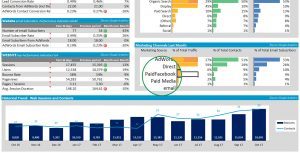When it comes to tracking Google Ads conversion options from your website there are two choices:
- Website: Insert code on a conversion page on your website, or
- Import: Set and import your goal from Google Analytics.
Let’s take a close look at the advantages and disadvantages of the Google Ads conversion options:
Insert Code on Website Conversion Page
Warning: This is the technical of the Google Ads conversion options. Familiarity with html is very beneficial.
Copy and Paste Your Website Code
This Google Ads conversions option requires you to place Google Ads code on your website conversion page. The ‘conversion page’ is the page where your conversion action is confirmed. On an e-commerce website for example, the conversion page would be the order confirmation page; on a lead generation website, the conversion page would be the thank you page.
This Google Ads conversion option is very simple if you know and understand HTML. Without that HTML knowledge, this tracking method has several trap doors:
- Code does not work because it’s in the wrong place on the page
- The code is placed on too pages, so conversions are irrelevant
- Limited to only tracking Google Ads conversions – no social media, SEO, or other conversion sources.
Only tracks Google Ads
This Google Ads conversion tracking options This is a nice choice if you are generating website traffic solely from Google Ads. But let’s face it, you have more traffic sources than Google Ads: SEO, email, social media, etc. Tracking information from these traffic sources comes from Google Analytics. That means your Google Ads tracking is an island, not tracked in Google Analytics.
When to use Website Conversion Tracking
In my opinion… never.
This conversion tracking is restricted only to Google Ads, making it difficult to compare with other website traffic sources like social media, SEO, email blasts, etc. Furthermore, unless a knowledgeable technical person is loading the code, there’s a risk of it being improperly implemented, which results in meaningless conversion information.
While among the Google Ads conversion options, this one looks simple, but a minefield of possible mistakes if you do not know HTML and exactly where the code should be placed on the specific page.
Table 1 Summary Google Ads Website Conversion Tracking
| Pros | Cons |
| Looks easy | Tracks only Google Ads |
| Need to know HTML so code inserted properly | |
| Code must be inserted in correct place on page | |
| Doesn’t track other conversions made on your website (ex: email clicks, phone number clicks) |
The better of the Google Ads Conversion Options:
Import Goal from Google Analytics
Google Analytics is free website tracking software that tells you about your website audience—the pages they visit, the buttons they clicked and a lot more. Most significantly, Google Analytics will tell you if people did what you wanted them to do on your website—made a purchase, became a sales lead, signed up for your newsletter, etc.
Anything you want people to do on your website is called a goal in Google Analytics. So, whatever you want people to do should be set up as a goal.
The biggest advantage of using ‘Import goal from Google Analytics’ is you can compare Google Ads’ performance to your other traffic sources: SEO, direct, email, social media, etc. Just look at the screenshot below taken directly from Google Analytics. You can see the number of sessions and the number of times website users became sales leads by requesting contact with the company.
This is an instant website traffic source comparison, valuable to any business.
Even better, notice the drop-down arrows on ‘Sessions’ and ‘Request contact Goal 3 Completions’. Those dropdown arrows enable comparison by any metric!
The ability to compare traffic sources against each other is invaluable. So is the ability to compare many different metrics. This is the kind of data that provides significant insights into marketing campaigns.
The biggest challenge of ‘Importing’ conversions to Google Ads is that you need to set up ‘Goals’ in Google Analytics, but that only takes a few minutes and generally is a non-technical procedure.
Table 2 Summary Google Ads ‘Import’ Conversion Tracking
| Pros | Cons |
| Tracks all traffic sources (social media, SEO, email, etc.) in a single place | Must setup goals in Google Analytics (which you should do anyway) |
| Google Ads easily imports goals from Analytics | |
| Do not have to know HTML | |
| Enables multiple conversions to be grouped together (‘contact’ via form completion, phone or email can be grouped together) |
When to use the ‘Import Goals from Google Analytics’ for Google Ads Conversions
In my opinion… always. It’s installed with all my customers and part of the Google Ads Management Services.
Hopefully the reasons for importing goals from Google Analytics makes this your choice for conversion tracking. It will make your life a lot easier! Setting it up can be done in three easy steps:
- Set your goals in Google Analytics.
- Link your Google Ads and Google Analytics accounts.
- Import your goal(s) to Google Ads.
This Google Ads conversion tracking options is a much more comprehensive way to track your Google Ads conversions. You will be glad you did it!
See the Google ads conversion options help pages for more information.




